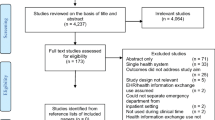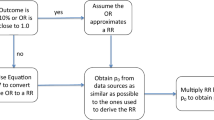Abstract
Case mix methods such as diagnosis related groups have become a basis of payment for inpatient hospitalizations in many countries. Specifying cost weight values for case mix system payment has important consequences; recent evidence suggests case mix cost weight inaccuracies influence the supply of some hospital-based services. To begin to address the question of case mix cost weight accuracy, this paper is motivated by the objective of improving the accuracy of cost weight values due to inaccurate or incomplete comorbidity data. The methods are suitable to case mix methods that incorporate disease severity or comorbidity adjustments. The methods are based on the availability of detailed clinical and cost information linked at the patient level and leverage recent results from clinical data audits. A Bayesian framework is used to synthesize clinical data audit information regarding misclassification probabilities into cost weight value calculations. The models are implemented through Markov chain Monte Carlo methods. An example used to demonstrate the methods finds that inaccurate comorbidity data affects cost weight values by biasing cost weight values (and payments) downward. The implications for hospital payments are discussed and the generalizability of the approach is explored.

Similar content being viewed by others
References
Steinbusch PJM, Oosterbrink JB, Zuurbier JJ, Schaepkens FJM (2007) The risk of upcoding in casemix systems: a comparative study. Health Policy 81:289–299
Busse R, Schreyogg J, Smith PC (2006) Editorial: hospital case payment systems in Europe. Health Care Manag Sci 9:211–213
Winters A, Ray N (2008) Paying accurately for imaging services in medicare. Health Aff 27:1479–1490
Hayes KJ, Pettengill J, Stensland J (2007) Getting the price right: medicare payment rates for cardiovascular services. Health Aff 26:124–136
Ginsburg PB (2006) Recalibrating medicare payments for inpatient care. N Engl J Med 355:2061–2064
Becker D, Kessler D, McClellan M (2005) Detecting medicare abuse. J Health Econ 24:189–210
Preyra C (2004) Coding response to a case mix measurement system based on multiple diagnoses. Health Serv Res 39:1027–1046
Silverman E, Skinner J (2004) Upcoding across hospital ownership. J Health Econ 23:369–389
Serden L, Lindqvist R, Rosen M (2003) Have DRG-based prospective payment systems influenced the number of secondary diagnoses in health care administrative data? Health Policy 65:101–107
Antioch KM, Walsh MK (2004) The risk-adjusted vision beyond casemix (DRG) funding in Australia. International lessons in high complexity and capitation. Eur J Health Econ 5:95–109
Wynn BO, Beckett M, Hillborne L, Scott M, Bahney B (2007) Working paper: evaluation of severity-adjusted DRG systems: interim report, WR-434-CMS. RAND Health, USA
Steinwald B, Dummit LA (1989) Hospital case-mix change: sicker patients or DRG creep? Health Aff 8:35–47
Sutherland JM, Botz CK (2006) The effects of misclassification on case mix measurement. Health Policy 79:195–202
Audit Commission (2008) Pbr data assurance framework 2007/08, findings from the first year of the national clinical coding audit programme. Audit Commission, London
Canadian Institute for Health Information (2003) CMG/Plx data quality re-abstraction study. Canadian Institute for Health Information, Ottawa
Bryngelsson S, Bolin P, Karlsson M (2007) Cost outlier, why? In: Proceedings of the PCSI 23rd working conference 7–10 November 2007. Patient Classification Systems International, Venice, Italy, 2007
Sutherland JM, Steinum O (2009) Hospital factors associated with clinical data quality. Health Policy. doi:10.1016/j.healthpol.2009.01.007
Ignatova I, Edwards D (2008) Probe samples and the minimum sum method for medicare fraud investigations. Health Serv Outcomes Res Methodol 8:209–22
Canadian Institute for Health Information (2003) Discharge abstract database data quality re-abstraction study, combined findings for 1999/2000 and 2000/2001. Canadian Institute for Health Information, Ottawa
Dalton K (2007) A study of charge compression in calculating DRG relative weights, January 2007 report. RTI International, Research Triangle Park
Botz CK, Sutherland JM, Lawrenson J (2006) Cost weight compression: impact of cost data precision and completeness. Health Care Financ Rev 27(3):1–12
Thorpe KE, Cretin S, Keeler EB (1988) Are the diagnosis-related group case weights compressed? Health Care Financ Rev 1988:37–46
Pettengill J, Vertrees J (1982) Reliability and validity in hospital case-mix measurement. Health Care Financ Rev 4(2):101–127
Jackson T (2001) Using computerised patient-level costing data for setting DRG weights: the Victorian (Australia) cost weight studies. Health Policy 56:149–163
Ontario Ministry of Health and Ontario Hospital Association (1999) Ontario guide to case costing version 2.0, joint initiative of the Ontario hospital association and the Ontario ministry of health. Ontario Ministry of Health and Long-Term Care, Toronto
Manning WG, Mullahy J (2001) Estimating log models: to transform or not to transform? J Health Econ 20:461–494
Marazzi A, Paccaud F, Ruffieux C, Beguin C (1998) Fitting the distributions of length of stay by parametric models. Med Care 36:915–927
Zhou X-H, Lin H, Johnson E (2009) Non-parametric heteroscedastic transformation regression models for skewed data with an application to health care costs. J R Stat Soc Ser B 70:1029–1047
Liu J, Chen R (1998) Sequential Monte Carlo methods for dynamic systems. J Am Stat Assoc 93:1032–1044
Brazauskas V, Jones BL, Zitikis R (2009) Robust fitting of claim severity distributions and the method of trimmed moments. J Stat Plan Inference 139:2028–2043
Hayes KJ, Pettengill J, Stensland J (2007) Getting the price right: medicare payment rates for cardiovascular services. Health Aff 26:124–136
Ginsburg PB (2006) Recalibrating Medicare payments for inpatient care. N Engl J Med 355(20):2061–2064
Ginsburg PB, Grossman JM (2005) When the price isn’t right: how inadvertent payment incentives drive medical care. Health Aff 376–384. doi:10.1377/hlthaff.w5.376
Clement FM, Ghali WA, Donaldson C, Manns BJ (2008) The impact of using different costing methods on the results of an economic evaluation of cardiac care: microcosting vs gross-costing approaches. Health Econ 18(4):377–388. doi:10.1002/hec
Lash TL, Mor V, Wieland D, Ferrucci L, Satariano W, Silliman RA (2007) Methodology, design, and analytic techniques to address measurement of comorbid disease. J Gerontol Ser A Biol Sci 62(3):281–285
Acknowledgements
The authors would like to acknowledge the Ontario Ministry of Health and Long-Term Care for providing access to the data for this project and for supporting case mix measurement improvement initiatives. The authors would also like to thank the reviewers whose comments and insights have improved this manuscript.
Author information
Authors and Affiliations
Corresponding author
Rights and permissions
About this article
Cite this article
Sutherland, J.M., Hamm, J. & Hatcher, J. Adjusting case mix payment amounts for inaccurately reported comorbidity data. Health Care Manag Sci 13, 65–73 (2010). https://doi.org/10.1007/s10729-009-9112-0
Received:
Accepted:
Published:
Issue Date:
DOI: https://doi.org/10.1007/s10729-009-9112-0




